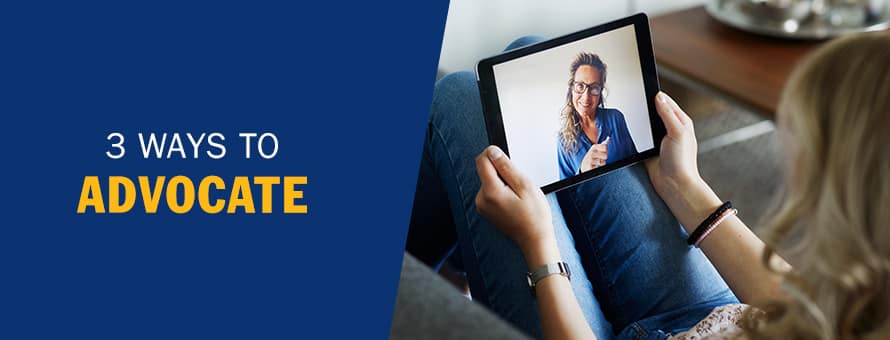Taking Action: A Fight for Mental Health

In just a few short months, since beginning this series, so much has changed. In Part 1 and Part 2, I began using metaphors of balloons and memorable children’s toys to illustrate the complexities, shared experiences and interwoven nature of mental health. Now, as we move through a global pandemic, national unrest and tumultuous election results, I can’t help but feel a metaphor no longer carries the weight needed to convey the realities we face.
Instead of asking you to imagine, I ask you this time to see the needs around you and consider what we must do to ensure we meet the mental health needs that are not just present but rising. Consider what your role might be as a mental health advocate; someone who gives a voice to the problems and potential solutions related to mental health and mental health awareness. To advocate means more than just giving voice; it means to fight.
Your initial question may be “How do we fight?” It may help to first talk about where changes happen and the ways in which they can occur. Change can occur in relation to self, peers, groups, professions, cultures, nations and even globally. Advocacy can be described as taking action to bring about meaningful change related to a cause, policy or belief. For simplicity’s sake, let’s narrow this down to self advocacy, individual advocacy and systems advocacy. We know that efforts in all three of these areas impact one another, although in different ways.
Fighting for Yourself
Self-advocacy is just what it sounds like – advocating for yourself to meet your needs. Most of us may do this a great deal already. Maybe you get the wrong take-out order and have to talk to the restaurant to correct it. Maybe you need to set good boundaries with your friends and family so that you can get your schoolwork done and take time for self-care. As they relate to mental health and mental health awareness, your actions to care for yourself and your mental health will not just help you, but also lead others to realize the needs that may exist for someone else.
Simply put, fighting for yourself is fighting for others. When you take the time to ensure that you receive the proper care, support, counseling and other services you need, you help to ensure those same services are provided to others. Those that provide services often do so based on need, and caring for yourself in this way helps to ensure those needed services continue to be offered to others. By taking care of yourself and your needs, you can also model for others the importance of mental health, how to advocate for your needs and how to engage with the systems that provide care and payment. Additional ways to fight may include educating others on mental illness. Another example is pushing back against shame and stigma that you see online, in social media and in person.
Fighting for Someone Else
This leads us to individual advocacy or fighting for others. Instead of advocating for your needs, individual advocacy simply means to advocate for another. As an individual advocate, your focus is on addressing issues that can present themselves in interactions with individuals, groups or entire systems.
Again, you probably do at least some of this already. Those with children attending school online may advocate for their children to receive equitable services from their school counselors or help with managing an online school day. You may advocate for those you serve in your professional role by providing your customers, clients, students and other stakeholders with the necessary support they need. Individual advocacy for mental health needs and promoting awareness may involve addressing abuse, finding appropriate services for someone, navigating the payment system for services and even confronting discrimination.
Fighting for All
These efforts often involve engagement with systems, namely our healthcare/mental health system, to ensure the individual you are advocating for receives what they need.
However, as with other forms of advocacy, sometimes interaction with these systems is just not enough to bring about substantial change. To influence change in policies, rules and even laws, our efforts need to move from bring generated by an individual to the formation of larger groups.
To bring the fight to systems, efforts at this level need some key elements to be successful. The first is to assemble a group, or join one if one exists, that builds influence through numbers and helps to maintain a consistent voice. This group would need to focus on the same problem – in this case mental health – and agree on the nature of the problem, the efforts needed to change it and be committed to a singular effort.
The key element to advocacy and change is that we don’t have to engage in all of these. Even engaging in one area can, at least in some way, positively impact the other. I asked you first to see, rather than imagine, the issues we face related to mental health. Whether you choose to advocate for yourself, for others or for systemic change, your efforts will be noticed. Your efforts will be meaningful. And, with enough of us as mental health advocates, we have hope for real and meaningful change in how we care for ourselves and one another.
Dr. Eric J. Perry, NCC, ACS, is a clinical faculty member in Southern New Hampshire University's master’s in clinical mental health counseling program. Dr. Perry is a Nationally Certified Counselor (NCC) and Approved Clinical Supervisor (ACS), with experience in community counseling and K-12 treatment settings.
Explore more content like this article

Academic Spotlight: Dr. Laman Tasch, Associate Dean of Academic Strategy, Social Sciences

Why Earning His BA in Political Science Mattered to Anthony Fernandez

What Can You Do With a Master’s in Criminal Justice?
About Southern New Hampshire University

SNHU is a nonprofit, accredited university with a mission to make high-quality education more accessible and affordable for everyone.
Founded in 1932, and online since 1995, we’ve helped countless students reach their goals with flexible, career-focused programs. Our 300-acre campus in Manchester, NH is home to over 3,000 students, and we serve over 135,000 students online. Visit our about SNHU page to learn more about our mission, accreditations, leadership team, national recognitions and awards.


